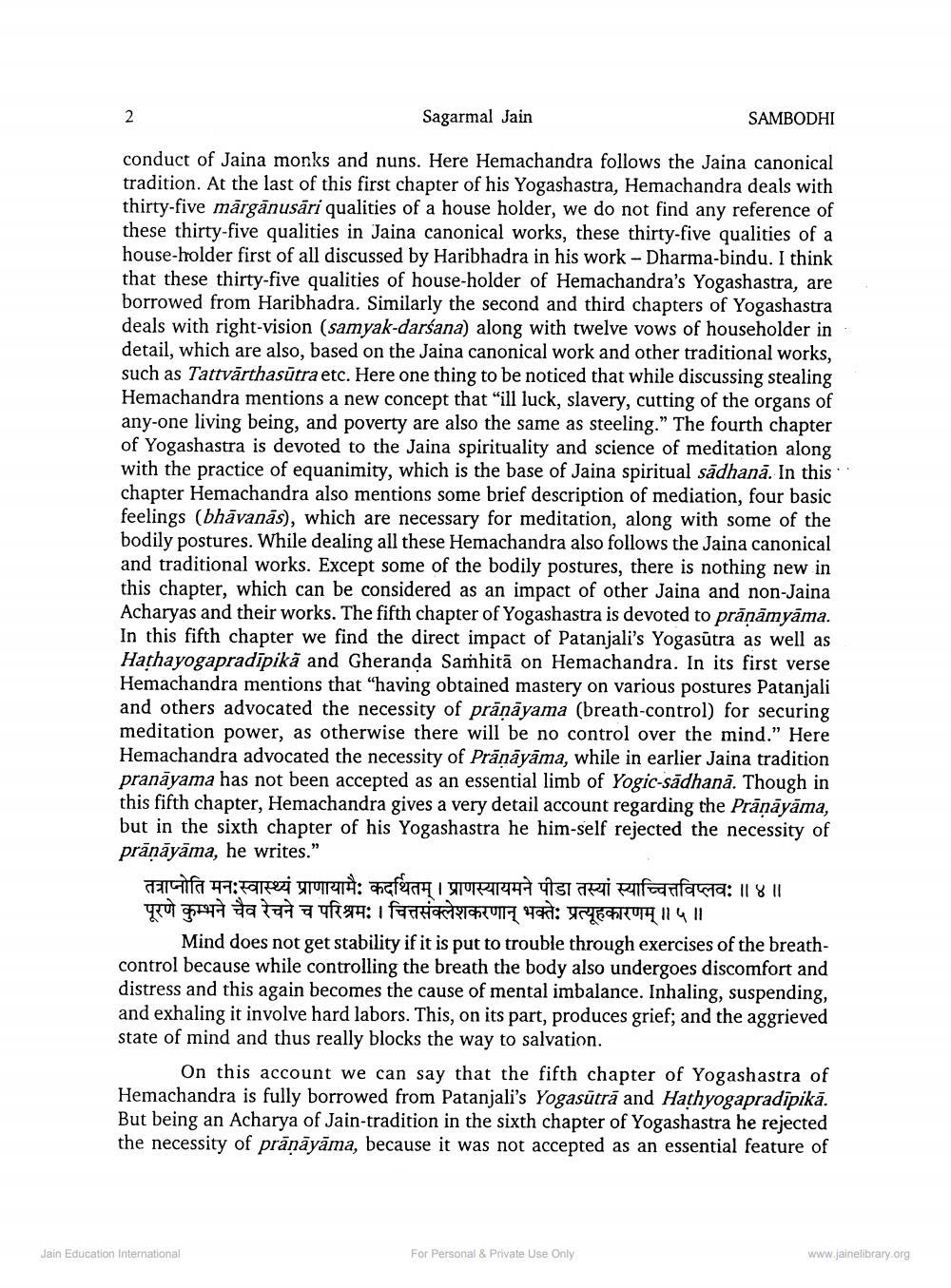Book Title: Sambodhi 2011 Vol 34 Author(s): Jitendra B Shah Publisher: L D Indology Ahmedabad View full book textPage 8
________________ Sagarmal Jain SAMBODHI conduct of Jaina monks and nuns. Here Hemachandra follows the Jaina canonical tradition. At the last of this first chapter of his Yogashastra, Hemachandra deals with thirty-five märgänusäri qualities of a house holder, we do not find any reference of these thirty-five qualities in Jaina canonical works, these thirty-five qualities of a house-holder first of all discussed by Haribhadra in his work - Dharma-bindu. I think that these thirty-five qualities of house-holder of Hemachandra's Yogashastra, are borrowed from Haribhadra. Similarly the second and third chapters of Yogashastra deals with right-vision (samyak-darśana) along with twelve vows of householder in detail, which are also, based on the Jaina canonical work and other traditional works, such as Tattvärthasutra etc. Here one thing to be noticed that while discussing stealing Hemachandra mentions a new concept that "ill luck, slavery, cutting of the organs of any-one living being, and poverty are also the same as steeling." The fourth chapter of Yogashastra is devoted to the Jaina spirituality and science of meditation along with the practice of equanimity, which is the base of Jaina spiritual sadhana. In this chapter Hemachandra also mentions some brief description of mediation, four basic feelings (bhāvanās), which are necessary for meditation, along with some of the bodily postures. While dealing all these Hemachandra also follows the Jaina canonical and traditional works. Except some of the bodily postures, there is nothing new in this chapter, which can be considered as an impact of other Jaina and non-Jaina Acharyas and their works. The fifth chapter of Yogashastra is devoted to präṇāmyāma. In this fifth chapter we find the direct impact of Patanjali's Yogasûtra as well as Hathayogapradipika and Gheranda Samhita on Hemachandra. In its first verse Hemachandra mentions that "having obtained mastery on various postures Patanjali and others advocated the necessity of pranayama (breath-control) for securing meditation power, as otherwise there will be no control over the mind." Here Hemachandra advocated the necessity of Präṇäyäma, while in earlier Jaina tradition pranayama has not been accepted as an essential limb of Yogic-sädhana. Though in this fifth chapter, Hemachandra gives a very detail account regarding the Präṇāyāma, but in the sixth chapter of his Yogashastra he him-self rejected the necessity of prāṇāyāma, he writes." 2 तत्राप्नोति मनःस्वास्थ्यं प्राणायामैः कदर्थितम् । प्राणस्यायमने पीडा तस्यां स्याच्चित्तविप्लवः ॥ ४ ॥ पूरणे कुम्भने चैव रेचने च परिश्रमः । चित्तसंक्लेशकरणान् भक्तेः प्रत्यूहकारणम् ॥ ५ ॥ Mind does not get stability if it is put to trouble through exercises of the breathcontrol because while controlling the breath the body also undergoes discomfort and distress and this again becomes the cause of mental imbalance. Inhaling, suspending, and exhaling it involve hard labors. This, on its part, produces grief; and the aggrieved state of mind and thus really blocks the way to salvation. On this account we can say that the fifth chapter of Yogashastra of Hemachandra is fully borrowed from Patanjali's Yogasüträ and Hathyogapradipikā. But being an Acharya of Jain-tradition in the sixth chapter of Yogashastra he rejected the necessity of pränäyäma, because it was not accepted as an essential feature of Jain Education International For Personal & Private Use Only www.jainelibrary.orgPage Navigation
1 ... 6 7 8 9 10 11 12 13 14 15 16 17 18 19 20 21 22 23 24 25 26 27 28 29 30 31 32 33 34 35 36 37 38 39 40 41 42 43 44 45 46 47 48 49 50 51 52 53 54 55 56 57 58 59 60 61 62 63 64 65 66 67 68 69 70 71 72 73 74 75 76 77 78 79 80 81 82 ... 152
